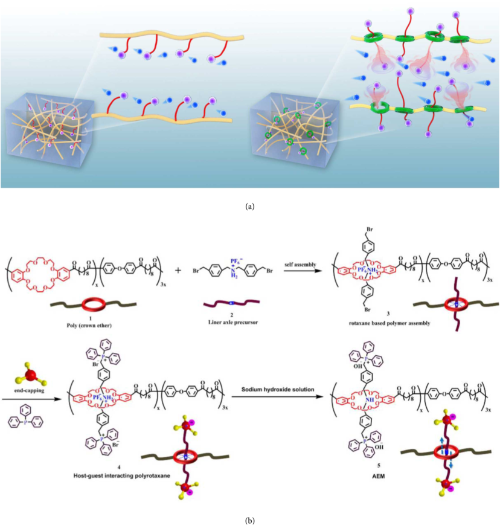Fast Bulky Anion Conduction Enabled by Free Shuttling Phosphonium Cations
Insufficient ion conductivity of alkaline membrane (anion exchange membranes, AEMs) are still the bottleneck of various energy generation/conversion technologies where fast anion transfer is required. Typically, AEMs are composed of a mechanically robust polymer backbone, tethered cationic groups, and free mobile counter anions like OH-, Br-, and HCO3-. In the traditional anionic membrane structure, side chains are grafted onto the polymer main chain via covalent bonding, thus the mobility of ion conducting groups are largely restricted., As a result, the ionic conductivity of AEM depends heavily on the content of functional groups. In order to obtain high ionic conductivity, the conventional approach is to improve the content of functional groups within the membrane matrix, i.e. increasing the ion exchange capacity (IEC). However, higher IEC will inevitably lead to the increase of membrane swelling and the reduction of the dimensional stability. This so-called "trade-off" effect seriously restrict the further application and development of the ionic membrane. Therefore, achieving high conductivity under low IEC condition remains a challenging task in the membrane community.
Recently, a research team at University of Science and Technology of China (USTC) developed a new strategy to address the above challenge. “Inspired by molecular machines, we introduced mechanical interlocking structures into ionic membrane materials”, said Tongwen Xu, who led the research. “In contrast to traditional methods, the side chain is grafted to the backbone via non-covalent bonds, which greatly improves the mobility of ion conducting groups”. (see Figure 1)
Figure 1: (a) Schematic illustration of polymer structure and ion conduction process in conventional tethered AEM and polyrotaxane AEM.(b) Synthetic procedure for polyrotaxane AEM from poly(crown ether) host 1 and linear guest 2.
This study was published (Research,2021) in Research, the first Science Partner Journal recently launched by the American Association for the Advancement of Science (AAAS) in collaboration with the China Association for Science and Technology (CAST). Xu is a professor of School of Chemistry and Materials Science in USTC.
“In this mechanically interlocked macromolecular architecture, a linear molecular guest was firstly mechanically confined within a crown ether macrocyclic host, then end capped with two steric hindrance phosphonium cations. NOESY 2D NMR well elucidated the host-guest intermolecular interaction. Unlike the covalently tethered quaternary ammonium group in conventional AEMs, the non-covalently threaded phosphonium cations have exceptionally higher mobility and broader motion range as evidenced by molecular dynamics simulation”, Xu said. “Solid-state and temperature-dependent NMR also revealed more obvious free shuttling behavior in response to increasing temperature”.
“The favorable advantages from the free shuttling phosphonium cations were demonstrated by comparing the conductivity of the polyrotaxane-based AEM and conventional tethered AEMs, our material exhibits a higher conductivity of 105 mS/cm under a lower IEC values of 1.17 mmol/g”, Xu said. “Broad applications of this unique polyrotaxane system in ion separation processes are currently in progress”.
Tag: Advanced Materials
Source: https://spj.sciencemag.org/journals/research/2021/9762709/

